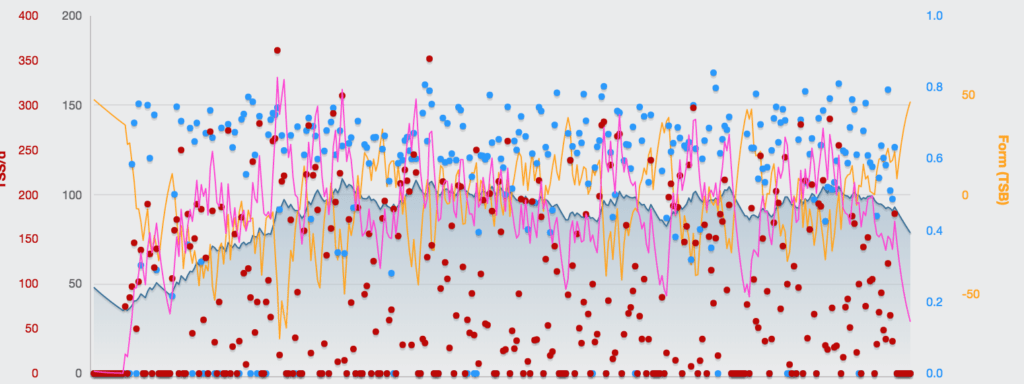As we venture through our 40s, balancing our passion for cycling with life’s ever-increasing demands can be challenging. In this post, I’ll discuss creating training plans that work for 40+ road cyclists. And these training tips also work when motivation seems to be on vacation.
The Reality of Motivation
If you’re in your 40s and juggling the demands of a busy life while trying to keep those wheels spinning, you’re in good company. Let’s chat honestly about something as elusive as a tailwind on a steep climb – motivation.
Motivation, that inner spark that gets us up at dawn for a ride, can be a fair-weather friend. It’s vibrant and compelling one day and seemingly non-existent the next. And here’s a truth we often overlook – it’s perfectly normal. As we navigate our 40s, our lives are often a tapestry woven with commitments: careers hitting their stride, family responsibilities peaking, and not to mention, the physical changes that whisper (sometimes a bit loudly) for attention.

The traditional image of motivation that burning, unwavering force, doesn’t always fit into this complex picture. It’s akin to expecting a consistent weather pattern in an ever-changing climate.
Some days, the motivation is there, your legs are itching to pedal, and the road calls your name. On others, it’s a struggle to even glance at your bike. This variability isn’t a failure; it’s a part of being human.
As a 40+ road cyclist, the unpredictability of motivation can be compounded by additional layers. There’s the mental fatigue from a demanding job. The emotional labor of family care. Or maybe just the simple, natural fluctuations in energy levels. All these factors can turn our cycling routine into an uphill battle, both literally and figuratively.
But here’s the silver lining – while motivation is a fickle friend, discipline is a steadfast companion. Discipline is born from structure and habit. It’s about creating a training rhythm that doesn’t hinge solely on the highs of motivation but thrives on the steady beat of routine. This approach respects the ebb and flow of our daily lives, acknowledging that not every day is geared for peak performance.
In the coming sections, we’ll explore how to harness this understanding into building a training plan that works with your life, not against it. We’ll dive into structuring your cycling routine so that it’s less about riding the wave of motivation and more about setting a sustainable pace that keeps you moving forward, even on those less-than-perfect days.
So, gear up, and let’s embark on this journey together, understanding and embracing the real nature of motivation in our cycling lives.
Well-Structured Training Plan for a 40+ Road Cyclist
In the world of cycling, just as in our daily lives, consistency often trumps intensity. But let’s face it, our motivation levels fluctuate like the stock market. There are days when we feel invincible, ready to conquer every hill, and then there are days when even putting on our cycling shoes feels like an impossible task. This is where the magic of a well-structured training plan comes into play.

Think about the last time you faced a seemingly insurmountable pile of tasks – at work, at home, or planning a vacation. The overwhelm often stems not from the task but from not knowing where to start. Now, imagine if you had a well-organized list, breaking down each process step. Suddenly, the mountain becomes a series of small, manageable hills. This is exactly what a structured training plan does for your cycling.
A well-crafted training plan is like a roadmap. It navigates you through the highs and lows of motivation, ensuring you stay on course regardless of how you feel on any given day.
It’s about transforming ‘I should ride today’ into ‘Today, I ride for 90 minutes focusing on my two 15-min sub-threshold intensity intervals’.
The specificity and structure eliminate the paralysis of choice – a common issue that hampers productivity in every sphere of life, from deciding what to cook for dinner to choosing a Netflix show.
The benefits of such a plan are manifold. Firstly, it brings consistency.
Consistency for a 40+ Road Cyclist is essential
Just as you wouldn’t expect to become proficient in a language by studying sporadically, you can’t maximize your cycling potential without regularity. A training plan ensures that you’re putting in the right amount of work, at the right time, for the right duration. And tailored to your individual fitness level and cycling goals.
Time management is another crucial aspect. A structured plan respects your time and helps you integrate cycling into your busy life. It’s about finding that sweet spot where your training complements rather than competes with your other commitments. This is akin to setting a regular time for meals or allocating specific hours for work meetings – it’s about creating a rhythm in your life.
Even professional cyclists, who live and breathe the sport, aren’t immune to the challenges of fluctuating motivation and the demands of life. They, too, rely on structured training plans, not just for physical preparation but also as a mental framework. It helps them stay grounded and focused. Turning what could be an overwhelming pursuit into a series of achievable daily goals.
In conclusion, a structured training plan is more than a cycling schedule. It’s a tool for life management, a strategy to align your passion for cycling with the practicalities of everyday living. It’s about making every pedal stroke count, ensuring that you’re not just riding but progressing, growing, and enjoying every moment on the bike.
If you want to explore the transformative power of establishing a strong ‘training discipline‘ take a look at my latest blog post. Learn how integrating cycling into your daily routines can significantly enhance your training effectiveness and overall well-being. I deliver practical tips on making cycling a non-negotiable part of your life, emphasizing the importance of routine over fleeting motivation. Dive into strategies for embedding this discipline seamlessly into your day-to-day, ensuring consistent progress and fulfillment in your cycling journey.
